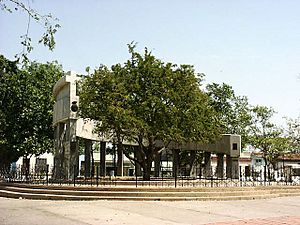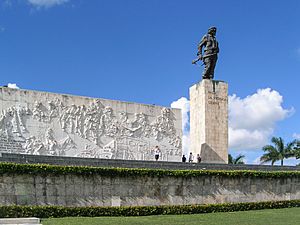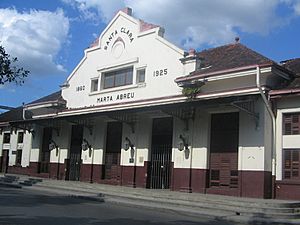Santa Clara, Cuba facts for kids
Quick facts for kids
Santa Clara
|
|||
|---|---|---|---|

A street in Parque Vidal, the heart of Santa Clara
|
|||
|
|||

Santa Clara municipality (red) within
Villa Clara Province (yellow) and Cuba |
|||
| Country | Cuba | ||
| Province | Villa Clara | ||
| Founded | 15 July 1689 | ||
| Established | 1 January 1690 | ||
| Area | |||
| • Total | 514 km2 (198 sq mi) | ||
| Elevation | 125 m (410 ft) | ||
| Population
(2022)
|
|||
| • Total | 245,959 | ||
| • Density | 478.5/km2 (1,239.4/sq mi) | ||
| Demonym(s) | Santaclareño | ||
| Time zone | UTC-5 (EST) | ||
| Postal code |
50100
|
||
| Area code(s) | +53 422 | ||
| Website | https://www.misantaclara.gob.cu/ | ||
Santa Clara is an important city in Cuba. It is the capital of the Villa Clara province. The city is located right in the middle of Cuba. Santa Clara is the fifth-largest city in Cuba. About 245,959 people live there.
Contents
History of Santa Clara
Santa Clara was started on July 15, 1689. About 175 people founded the city. Most of them were from two big families who already lived there. The rest came from a coastal city called San Juan de los Remedios. They were trying to escape pirates who often attacked their old city.
On June 1, 1689, these 37 people reached a hill. They joined the two families already living there. People say that a special church service happened under a tamarind tree. This is how Santa Clara was founded. The spot under the tree is now called Loma del Carmen, which means "Carmen's Hill." A church was built nearby later. Today, a monument with a tamarind tree marks this important spot.
The city had a few different names over time. It was called Cayo Nuevo, then Dos Cayos, and Villa Nueva de Santa Clara. Finally, it became known as Santa Clara.
The city was built with a main square, like many Spanish towns. This square is now called Parque Vidal. The first buildings were a city council hall and a church made of palm trees. The palm tree church was later replaced with a brick one in 1725. This brick church was in the center of Parque Vidal. But in 1923, it was taken down to make the park bigger. Many people still think this was a bad decision.
Soon after, Santa Clara grew quickly. A theater, a business center, and libraries were built. Because it was in the middle of the country, it became a popular stop for travelers. It also became a major transport hub. This helped the city grow steadily. By the 1800s, Santa Clara was bigger than nearby towns. It even became the capital of the Las Villas province.
Marta Abreu: A City Benefactress
Two famous people are linked to Santa Clara. One is Marta Abreu de Estévez. She was a kind woman known as "the Benefactress of the City." The other is Ernesto Che Guevara, a leader of the Cuban Revolution. He is buried in Santa Clara.
Marta Abreu was known for her generosity. She and her family helped build many things in Santa Clara. These projects made life better for the people. Marta and her husband, Luis Estévez, supported the Cuban rebels. They helped fight for Cuba's freedom from Spain.
Marta Abreu's gifts to the city are still seen today. She helped build an electric plant and several schools. She also funded an asylum and public laundry stations. The fire station near Parque Vidal and the train station were also built with her help.
Her most famous gift is the Teatro La Caridad. This theater is named after Cuba's patron saint. It stands near Parque Vidal. Marta Abreu paid for the entire project herself. She even oversaw its design and construction. The money earned from the theater helped support two schools she started. These schools were for poor children in the city. Teatro La Caridad is one of the oldest colonial theaters still standing in Cuba. Marta Abreu also gave her own palace to the city. It is now the Biblioteca Martí (Martí Library). This building is a beautiful example of neoclassical architecture. Santa Clara's university is also named after Marta Abreu.
Battle of Santa Clara
Santa Clara was the site of the last major battle of the Cuban Revolution. This happened in late 1958. Two groups of guerrilla fighters attacked the city. One group was led by Ernesto Che Guevara. The other was led by Camilo Cienfuegos.
Guevara's group first captured a military base in Fomento. They used a bulldozer to destroy railroad tracks. This derailed a train full of soldiers and supplies sent by Fulgencio Batista, the Cuban leader at the time. At the same time, Cienfuegos's group won a battle nearby.
On December 31, 1958, the combined forces attacked Santa Clara. The battle was confusing. Some soldiers fought, but others gave up quickly. By the afternoon, the city was captured. This victory was a turning point in the Cuban Revolution. Batista fled Cuba less than 12 hours later.
Geography of Santa Clara
Santa Clara is located on a flat area with hills nearby. It is about 71.5 kilometers (44 miles) from the Caribbean Sea. It is also about 51.7 kilometers (32 miles) from the Atlantic Ocean. The city shares borders with several other towns. These include Cifuentes, Camajuaní, Placetas, Manicaragua, and Ranchuelo.
The city is divided into many smaller areas called repartos. There are also 18 wards, or consejos populares. Some of these are in the city center, like Centro and Capiro. Others are in semi-urban areas, like Antón Díaz. A few are in rural areas.
Climate in Santa Clara
| Climate data for Santa Clara | |||||||||||||
|---|---|---|---|---|---|---|---|---|---|---|---|---|---|
| Month | Jan | Feb | Mar | Apr | May | Jun | Jul | Aug | Sep | Oct | Nov | Dec | Year |
| Mean daily maximum °C (°F) | 27 (81) |
28 (82) |
29 (84) |
29 (85) |
31 (87) |
32 (89) |
32 (90) |
32 (90) |
32 (89) |
31 (88) |
28 (83) |
28 (82) |
30 (86) |
| Mean daily minimum °C (°F) | 17 (63) |
17 (62) |
18 (64) |
19 (67) |
21 (69) |
22 (71) |
22 (72) |
22 (72) |
22 (71) |
22 (71) |
19 (67) |
18 (64) |
20 (68) |
| Average precipitation mm (inches) | 18 (0.7) |
25 (1) |
33 (1.3) |
46 (1.8) |
120 (4.7) |
150 (6) |
120 (4.8) |
160 (6.3) |
170 (6.8) |
160 (6.3) |
41 (1.6) |
23 (0.9) |
1,070 (42.2) |
| Source: Weatherbase | |||||||||||||
Santa Clara has a warm climate. The average high temperature for the year is 86°F (30°C). The average low temperature is 68°F (20°C). The city gets a lot of rain, especially from May to October.
Population of Santa Clara
In 2022, Santa Clara had a population of 245,959 people. The city covers an area of 514 square kilometers (198 square miles). This means there are about 480 people living in each square kilometer.
Fun Places to Visit in Santa Clara
Parque Vidal is the main park in the city center. It takes up a whole city block. You can see a statue of Marta Abreu there. Many important buildings are around the park. These include the Santa Clara Libre hotel, the Gran Hotel, and the Teatro La Caridad. The old city hall and a dance center are also nearby.
Parque Vidal is a classic Cuban meeting spot. In the afternoons, people, especially singles, go there to meet others. It used to be a tradition for women to walk on the inside of the park and men on the outside. Another old custom was for locals to play music and sing with their guitars on Sunday afternoons.
Santa Clara is also home to a mausoleum for Che Guevara. It holds his remains and those of 16 of his fellow fighters. They died in 1967 during a campaign in Bolivia. There is also a display that shows how Guevara's soldiers derailed the train during the Battle of Santa Clara.
Before 1977, Santa Clara was part of Las Villas Province. Then, Cuba reorganized its provinces. Las Villas Province was split into three new provinces. These were Villa Clara, Cienfuegos, and Sancti Spíritus. Santa Clara is now in the Villa Clara province.
Other interesting places to visit include:
- Parque del Carmen (Carmen's Park) – This is where the city was founded.
- Parque de los Martires (Martyrs' Park)
- Parque del Tren Blindado (The Armored Train Park-Museum) – This is a National Monument of Cuba.
- Mausoleo Che Guevara (Monument and Mausoleum of Ernesto "Che" Guevara)
- Catedral de Santa Clara de Asís (Saint Claire of Asis Cathedral)
- Centro Cultural El Mejunje (Cultural Centre "El Mejunje")
- Loma del Capiro – A hill with great views of the city.
- Villa Clara Provincial Museum – This museum shows art and history.
- University "Marta Abreu" of Las Villas – A major university.
Getting Around Santa Clara
Santa Clara is easy to reach. The main highway in Cuba, the Carretera Central, goes through the city. The Autopista A1 motorway also connects to Santa Clara. The city has a special road called the Santa Clara Beltway that links to the motorway.
The main train station, Santa Clara railway station, is part of Cuba's main railway line. This line connects Havana, Santa Clara, Camagüey, and Santiago.
The city's airport is Abel Santamaría Airport. It is about 11 kilometers (7 miles) north of the city. This airport has flights to countries like Italy, Canada, France, and Poland. It also has flights within Cuba.
The Santa Clara beltway connects the city to other roads. These roads lead to other towns in the province. For example, the Autopista Santa Clara goes to Havana. The Carretera Central goes to towns like Esperanza and Placetas. Other roads lead to places like Sagua La Grande, Caibarién, and the tourist resort of Cayo Santa María.
Education in Santa Clara
Santa Clara is home to the University "Marta Abreu" of Las Villas (Spanish: Universidad Central "Marta Abreu" de Las Villas (UCLV)). This university has many different study areas, called faculties. These include:
- Electrical Engineering
- Agricultural Sciences
- Mathematics, Physics, and Computer Sciences
- Humanities
- Law
- Psychology
- Social Sciences
- Construction
- Managerial Sciences
- Mechanical Engineering
- Chemistry and Pharmacy
- Distance Education
The university offers many types of degrees. It has helped over 35,000 students graduate. About 1,000 of these students were from 47 different countries. The university also works with schools in Germany, Argentina, Canada, France, Spain, and other countries.
Santa Clara also has the Universidad de Ciencias Médicas de Villa Clara. This is a medical university that started in 1966.
Famous People from Santa Clara
Many notable people come from Santa Clara:
- Marta Abreu (1845−1909), a kind person who helped the city.
- José Bernal, an artist.
- Yuniesky Betancourt, a baseball player.
- Mike Cuellar, a baseball pitcher.
- Aledmys Díaz, a baseball player.
- José Fernández (1992−2016), a baseball pitcher.
- Mirka Francia, a Cuban-Italian volleyball player.
- Rubén González, a famous pianist.
- Benny 'Kid' Paret (1937−1962), a boxer.
- Moraima Secada, a singer.
- Miguel Díaz-Canel, the current president of Cuba.
- Gerardo Machado y Morales, a general and former president of Cuba.
- Marilyn Pupo, an actress and TV host.
- Dafnis Prieto, a drummer and composer.
- Eslinda Núñez, an actress.
- Francisco Javier Balmaseda, a writer.
Santa Clara and Other Cities
Santa Clara has special connections with other cities around the world. These are called twin towns or sister cities.
 Cali, Colombia (since 1994)
Cali, Colombia (since 1994) Oviedo, Asturias, Spain (since 1995)
Oviedo, Asturias, Spain (since 1995) Bloomington, Indiana, United States (since 1999)
Bloomington, Indiana, United States (since 1999) Cheboksary, Chuvash Republic, Russia (since 2004)
Cheboksary, Chuvash Republic, Russia (since 2004) São Carlos, São Paulo, Brazil (since 2005)
São Carlos, São Paulo, Brazil (since 2005)
Images for kids
-
Che Guevara's monument and museum
See also
 In Spanish: Santa Clara (Cuba) para niños
In Spanish: Santa Clara (Cuba) para niños














